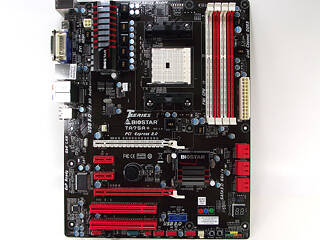 0
0
Biostar TA75A+ Socket FM1 Review
The Board - A Closer Look »The Board - Layout
With the board out of the box, the stylized theme of the Biostar TA75A+ really impresses, with the red, black, and white color theme broken here and there with a bit of hardcore metal. The rear of the board is simple and clean, thanks to the impressive connectivity of the AMD A75 chipset, allowing for simplistic board design.
The socket area of the board is quite clean and simple like the rest of the board, with the CPU_FAN1 power header in a non-standard location, at least for us, found below the CPU VRM. The rear of the socket, in contrast to many other boards we've looked at, is almost completely clear of protruding pins that might interfere with aftermarket backplates, with many solder "cooling strips" beneath the CPU VRM to help dissipate heat. The backside of the socket proper is completely filled with components, with not a single empty spot noticed.
With six expansion slots, the Biostar TA75A+ comes with two of everything, PCIe x16, PCIe x1, and PCI all inclusive. The white PCIe x16 slot is connected to the APU with a x16 link, while the red x16 slot is connected to the APU via a x4 link, the perfect pair for an add-on RAID card and a discrete GPU. The four DIMM slots can each be fitted with high density 8 GB DIMMs, while claiming support for up to a 2000 MHz speed.

We find all of the pin headers for internal expansion along the bottom edge of the board, with the addition of power and reset switches right next to the front panel pin header, making first set-ups a breeze. All of the pin headers, minus the front panel and COM header, are fitted with red plastic bases, really adding to the colored theme of the board, something that we really did not expect from such an inexpensive product. The TA75A+ features three separate fan headers, but only the 4-pin PWM CPU_FAN header can be controlled from within the BIOS and via included software.
On the board's right edge we find six SATA ports, each supporting 6 Gb/s drives. The backplate I/O starts off with a PS/2 port for keyboards and four USB 2.0 ports, quickly followed by a set of HDMI, VGA, and DVI ports driven by the APU's onboard Radeon cores. We also find a set of dual USB 3.0 ports, a six port audio header, and rounding it all out is a single RJ-45 LAN connector.
The board's chipset has a relatively small cooler on it, with a low profile so as to not interfere with expansion cards. Removing the stylized heatsink we find the AMD A75 chipset below, set at a 45-degree angle like AMD's current line of high-performance GPUs.
Feb 24th, 2025 07:00 EST
change timezone
Latest GPU Drivers
New Forum Posts
- Help choose M.2 Key E Wifi card (0)
- It's happening again, melting 12v high pwr connectors (908)
- Throw Noctua alternatives at me pls (3)
- RDNA4 Prediction Time Part Deux!!! (42)
- [Testers-Needed] Converting Any Realtek Ethernet to Intel Killer Ethernet chip (87)
- [Intel AX1xx/AX2xx/AX4xx/AX16xx/BE2xx/BE17xx] Intel Modded Wi-Fi Driver with Intel® Killer™ Features (277)
- Monitor Battle! Help me choose between two contenders (42)
- Warning about DOCP (18)
- help me find the right bios for my his RX580 Iceq2 X 8Gb (6)
- mV boost option greyed out/ CPU Cache isn't separated by P and E/Cinebench Crashing even with no undervolt (1)
Popular Reviews
- ASUS GeForce RTX 5070 Ti TUF OC Review
- MSI GeForce RTX 5070 Ti Ventus 3X OC Review
- darkFlash DY470 Review
- MSI GeForce RTX 5070 Ti Vanguard SOC Review
- MSI GeForce RTX 5070 Ti Gaming Trio OC+ Review
- Galax GeForce RTX 5070 Ti 1-Click OC White Review
- Palit GeForce RTX 5070 Ti GameRock OC Review
- Fantech Aria II Pro Review
- Gigabyte GeForce RTX 5090 Gaming OC Review
- AMD Ryzen 7 9800X3D Review - The Best Gaming Processor
Controversial News Posts
- NVIDIA GeForce RTX 5090 Spotted with Missing ROPs, NVIDIA Confirms the Issue, Multiple Vendors Affected, RTX 5070 Ti, Too (458)
- AMD Radeon 9070 XT Rumored to Outpace RTX 5070 Ti by Almost 15% (304)
- AMD Plans Aggressive Price Competition with Radeon RX 9000 Series (271)
- AMD Radeon RX 9070 and 9070 XT Listed On Amazon - One Buyer Snags a Unit (247)
- Edward Snowden Lashes Out at NVIDIA Over GeForce RTX 50 Pricing And Value (241)
- AMD Denies Radeon RX 9070 XT $899 USD Starting Price Point Rumors (239)
- NVIDIA Investigates GeForce RTX 50 Series "Blackwell" Black Screen and BSOD Issues (236)
- New Leak Reveals NVIDIA RTX 5080 Is Slower Than RTX 4090 (215)











